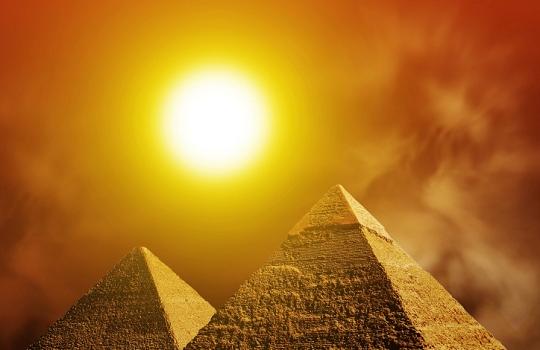Did training play an important part in the building of the pyramids? John Stein compares the learning and development practices of both Egyptian Pharaohs and today's leaders.
The Great Pyramid at Giza, built for King Khufu in 2589 BC, is the only survivor of the ‘Seven Wonders of the World’ and is the largest pyramid built by any of the Egyptian Pharaohs.
There are 80 other similar monuments still standing today – a testament to the ambition of the Pharaohs and the dedication and work ethic of the people of ancient Egypt.
Impressive perhaps, but something bothers me about the construction of these fine edifices.
Pharaohs, architects and high officials get the credit for the building of the pyramids, but rarely do we hear about the work of the trainers on the journey.
Why is this? Was training important in the plan to build these magnificent monuments? If it was, what learning and development lessons can we take from the Pharaohs and their scholars?
My research work for Building the Pyramid unearthed a few powerful insights:
Lesson 1: Similarities between the old world and new world journey
To begin with, the Pharaoh and the modern-day leader shared a common single-minded determination to create something totally unique.
The Pharaoh’s desire was to build a monument that could not only transfer him to the new world, but would be a dynamic place where his people could relax, worship, and proudly say ‘we built that’.
In the case of forward-thinking leaders today, the desire is to build a solid and successful organisation. They aim to create an outstanding and sustainable organisation which differentiates from others in their sector or marketplace. Like the pyramid, the organisation is designed for the living. For people to say ‘we built that’.
Both journeys involve the initial development of a vision by a single person.
Leadership plays a critical role in the development, support to, and realisation of any vision, whether you are a Pharaoh or a Chief Executive.
Lesson 2: Navigating the landscape on the journey
In order to ensure people remained focused, on track and committed to building the pyramid, navigating the landscape was recognised by the Pharaohs as one of the most important skills needed of their leadership team.
Steering an organisation on its unique journey is one of the biggest personal challenges facing all leaders. Although the end goal, the destination, may stay the same, the conditions experienced on the journey will be different within six months, and different again within a year. Why? Because internal and external issues will constantly change the landscape in which the organisation operates.
In the modern world ‘navigating the landscape’ has become the new core requirement of the 21st century leader.
Learning and development plays an important part in equipping leaders with the knowledge and skills required to navigate the journey.
Lesson 3: Human performance challenges on the journey
‘Navigation’ requires a detailed understanding of the challenges facing the organisation and the important use of momentum to deliver the high levels of performance needed to achieve success.
Performance challenges on any journey can be grouped into six clearly defined stages:
- The attraction and recruitment of talent
- The alignment of strategy to operational performance
- The engagement of others via the development of leadership capability
- The creation of a strong workplace performance climate
- The powerful use of knowledge, expertise and talent via learning
- The demonstration of behaviours important to maximising the organisation’s potential.
The high officials from ancient Egypt faced the same people challenges of modern-day leaders – from resignation to recruitment, cynicism to optimism, complacency to commitment. Little has changed in over 4,000 years.
Navigational ‘excellence’ is achieved by matching challenges to leadership focus.
Lesson 4: The importance of trust on the journey
Leading people into the unknown – whether in ancient times or today - is also an important but unexpected similarity on each journey.
It could take 20 years to build the pyramid, meaning that few Egyptian people had previous experience, and the workforce would constantly change during its construction. People were therefore asked to take a leap of faith and trust the leader (the Pharaoh), his officials and the journey.
The workforce of an organisation today with new, ambitious and exciting plans for change and growth are similarly asked to trust the leaders, many of whom may have little experience and knowledge of the unique dynamic of growing and developing a sustainable organisation.
Maintaining a culture of trust was an important people objective in ancient Egypt. Creating a learning environment, improving communication and the development of leadership capability supported the people development process.
Lesson 5: The participative experience of the journey
Pharaohs recognised that in order to gain buy-in and commitment to their vision – the construction of the perfect pyramid - the powerful participative experience of the journey could be used to inspire others to support the cause.
Today, in many organisations, very few leaders view work and the workplace experience in the context of a journey. The day-to-day pressures of managing the organisation often get in the way of thinking of work as anything other than an intense process of actions, activities and decisions.
A change in mindset and thinking linked to the journey context will reap massive benefits for everyone connected to the organisation.
Journeys are important. Journeys are a part of all of us.
The journey of each organisation is no different to any other life journey, and is just as rewarding. But only if leaders are prepared to view the day-to-day work experience as an adventure – as a journey.
Lesson 6: Everyone dreams of being part of something special
Great journeys live long in the memory of those who participate in them and, considering how much time people devote to their work, creating a journey worth embarking on will make work and the workplace a more enjoyable experience.
Great journeys involve an inspirational experience, challenges along the way and a desire to reach the destination with people you admire and respect.
Every single person brings something unique to the journey including trainers, the modern-day scholars.
Great trainers produce and deliver great content. Great trainers inspire individuals to build great pyramids.
Great trainers help to create great journeys.
Next time you see a pyramid, remind yourself that insight, experience, evidence and myth – pieced together on hieroglyphic walls - present a powerful understanding of the wisdom and skill of the learning and development professional.
Best wishes on your journey, wherever it may take you.
John Stein is the founder of the winning (formula)® and the author of the new leadership development parable Building the Pyramid (ISBN 9780954713416).










